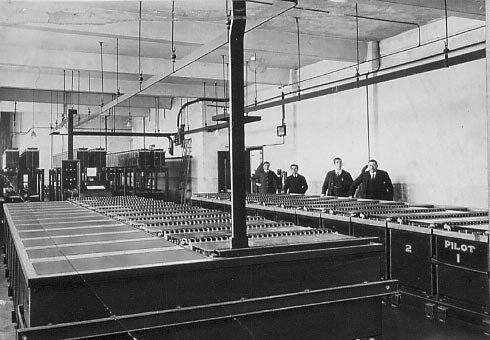
Fenny Stratford Repeater Station
Battery Room
The 'A' batteries supplied the valve filaments and consisted of 2 sets, made up of 12 cells in each. These provided 24 volts DC at a capacity of 5075 ampere hours, with an ultimate capacity of 9450 ampere hours. The cells were made of wood, probably teak or mahogany, and lined with lead. Each one weighed 2 tons 4 cwts. The total weight of the 'A' battery was around 53 tons. One 'A' battery would be on charge whilst the other was on load supplying the valve filaments.
The 'B' batteries supplied the high tension requirements of the apparatus. There were 3 sets, each made up of 75 cells, giving 150 volts DC at a capacity of 300 ampere hours. These sets were used as follows:
1 to supply the valve anodes.
1 for electric lighting and driving ancillary generators.
1 on charge, or held in reserve.
The 'C' batteries were made up of 2 sets of 5 cells, each providing 10 volts at a capacity of 20 ampere hours. These were used to bias the grid circuits of the valves.
The 'D' batteries consisted of 2 sets of 10 counter EMF cells, each giving 20 volts for opposing a 'B' battery, these regulated the terminal voltage to 130 volts DC of the particular 'B' battery that was supplying the valve anodes.
The total number of cells in the Battery Room was 284.
 |
|
A view of the Battery Room. The 'A' batteries in the foreground and the 3 sets of 'B' batteries can be seen at the rear. Staff from left to right: J. T. Barnes, J. Sunderwall, C. J. Jones and G. D. Line.
|